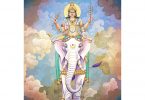Question: The word ‘sannyasi’ means one in the renounced order of life, which also means being away from homely comforts. But how is that some sannyasis [gurus] hold administrative positions and material assets [fixed and liquid], accept material gifts and tend to lead an opulent life style [taking very opulent prasadam, jet traveling, doing shopping during foreign trips etc.] Is it that if one is spending 24 hours of his time in Krishna consciousness, he is exempted from the above rules?
Answer by Romapada Swami: Being affected by one’s position of respect, or worse, abuse of that position, is very detrimental to a spiritually accomplished person, and should be closely guarded against by a sincere bhakta. According to Visvanath Cakravarti Thakur, labha, puja and pratistha are sources of unwanted conditions of heart (anarthas) for anyone who becomes a little spiritually capable. Your concerns and cautions are most warranted.
Serving Krishna from a position of administration, or using technology in His service (eg air travel), however, are not in themselves blemishes upon the ashram of sannyasa. I will attempt to explain.
The general idea of sannyasa, which is especially popular among the impersonalists school, is that everything material has to be rejected. However the vaishnava understanding of renunciation is quite different. Vaishnavas see everything as belonging to Narayana and therefore to be used in the service of Narayana. As vairagya is symptom of sannyasa, yukta-vairagya must also be carefully considered in the service of a vaishnava sannyasi.
Prabhupada gives the example of a hundred dollar bill lying on the street. One man might pocket it, while another man may think that it does not belong to him and walk away in a spirit of renunciation. Yet another person might pick it up, find its original owner and return it to him. This third position is the most honest, and the most intelligent.
Living one’s life in this world according to this principle is called ‘yukta vairagya’, or detachment by dovetailing everything in Krishna’s service. Srila Rupa Gosvami, one of our principal acaryas and follower of Lord Caitanya, taught this principle of yukta vairagya. That renunciation which shuns things which can be useful in relation to the service to Lord Hari, he says, is in fact ‘phalgu’ or false renunciation! This is a very deep concept, however, and only those who are completely free from the propensity to enjoy and fully surrendered to the Lord can successfully implement it – to go fishing but not get wet, as they say! So, your note of caution is well deserved.
Time and again we see the principle of yukta-vairagya exhibited in the lives of great acaryas – Sanatana Gosvami, Rupa Goswami, and in recent times by Srila Bhaktisiddhanta Saraswati and ISKCON’s founder acarya Srila Prabhupada. They engaged wealthy disciples in building grand temples for Lord Krishna and dealt with worldly men and matters, but strictly to spread Krishna consciousness only. On my wall right by my desk in NY, I have a photograph of Srila Bhaktisiddhanta Saraswati Thakur riding in a convertible car, decked out in an overcoat and turban, driving right through the main shopping streets of Vrndavan! He was making a strong statement to those not understanding the principle of yukta-vairagya: for Krishna’s service, a renunciate can accept a wide range of facilities–*IF* they are accepted in a mood of service to Krishna, only.
Our Srila Prabhupada set an example by traveling around the globe, building grand temples, printing and distributing millions of dollars worth of books, and accepting the worship of thousands of adoring disciples. Yet his followers have repeatedly recorded his remarkable detachment, renunciation, humility and simplicity. He extended his efforts of humble service to Krishna, and accepted the worship and profit in the mood of a menial representative of Krishna — much like a bank clerk may deal with transactions of hundreds of thousands but does not claim anything for himself. Srila Prabhupada’s purpose was simply to glorify Krishna, in service to his guru maharaja.
In conclusion, we have to carefully consider one’s capacity utilize some part of God’s creation fully in the spirit of detatchment. While it is true that certain activities are strictly forbidden for a sannyasi, utilizing products of technology and accepting overseeing posts in service to the mission of spreading Krishna consciousness are not fundamentally in that category. When exercising caution in estimating what is an appropriate application of the yukta vairagya principle, it is best to err on the side of caution, especially for a sannyasi, while abuse of this principle is never condoned. Yet we must not forget that the essence of the renounced order of sannyasa is attachment to Krishna; a sannyasi’s sacrifices and efforts to utilize God’s creation in the Lord’s service may well be an actual demonstration of his sannyasa. (Please refer to Bhagavad-gita As It Is, Verses 5.3, 5.6, and 6.1)







